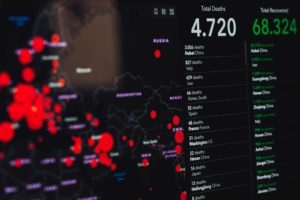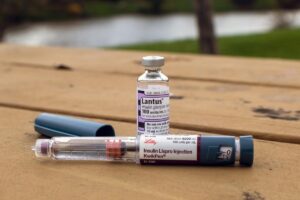COVID-19, Influenza & RSV Testing in Chicago

What is the triple pandemic?
The Winter of 2023-2024 is showing a rapid increase in Influenza, COVID, and now, RSV infections – the 3 infections being called the “tripledemic”
The CDC is reporting a rapid rise in cases of all 3 types of respiratory viruses – COVID, influenza, and now a mix of a third pathogen – respiratory syncytial virus (RSV) causing a “tripledemic.” So individuals are at risk of getting 1,2, or even 3 infectrions at the same time that results in much more severe illness, risk of hospitalization and death.
We already had COVID and the flu, but RSV also entered the picture this fall. RSV usually affects children but this winter, it is also affecting adults and the RSV hospitalization rate for seniors is 10 times higher than usual for this point in the season. It is therefore so important that we have a combined RSV, flu and COVID test.
RSV
We already had COVID and the flu, but RSV has entered the picture this fall. According to the CDC, 58 000 to 80 000 children, or 1-2% of children under the age of six months who have RSV infection, are at risk for hospitalization. When we think about RSV, we can vividly recall many assumptions that only children can get them.
So, should adults be worried about RSV as well? RSV has symptoms similar to the flu or a cold and is sometimes underestimated by many adults of how severe it could be and its fatality. In the United States, CDC’s statistics demonstrate that 60,000–120,000 older adults are hospitalized yearly, and 6,000–10,000 pass away from RSV infections. Not only that, but RSV can also exacerbate pre-existing chronic conditions such as asthma and congestive heart failure or, if not, lead to severe conditions, including pneumonia and bronchiolitis.
According to the New York Times article, there is currently no vaccination for RSV. Still, at least two candidates are in late-stage clinical trials and seem highly effective in older adults. Additionally, Pfizer is developing an antiviral medication.
Why are the Flu and COVID unique this year?
According to Helix, a lab that assists the CDC with viral surveillance, almost 98 percent of COVID-19 reinfections occur in people who had already been exposed to the virus more than 90 days ago, suggesting that declining immunity — rather than more transmissible variations — is driving the surge.
Until recently, the BA.5 strain was the most adept at evading immunity, but others quickly replaced it. The New York Times COVID-19 surveillance accentuates that the most likely contender for starting a winter wave is one of them, known as BQ.1.1, which has already caused cases to a spike in Europe. The number of cases in some states has increased by as much as 50% over the past two weeks.
Additionally rising are COVID-19-related hospital admissions. According to the CDC COVID-19 surveillance, two new variants—BQ.1.1 and BQ.1—are leading as the second and third highest variants, adding to the rising COVID instances. Until recently, the BA.5 variant was the most prevalent.
Contradictory to President Joe Biden’s statement, “The pandemic is over,” the United States is experiencing a unique respiratory virus transmission season. The flu cases are increasing earlier than usual, and RSV incidence rates are exceptionally high in children and adults, even after an unprecedented early increase this summer.
Why should you test ASAP for all 3? Can I get two or even three infections at the same time?
• People are getting co-infections that can be more severe
It is challenging to distinguish between the COVID-19, RSV, or the flu since they have similar symptoms; getting tested is the best approach to determine which infection you have.
You may have either one of the viruses -COVID, Flu, or RSV – or you may have a combination of them. Having more than 1 virus causes more severe illness and takes you out for a much longer period.
In addition, in COVID and Influenza infections, it is very important to start treatment with Paxlovid, or Tamiflu respectively. These reduce severity and duration of illness. Further Paxlovid has also been demonstrated to decrease the incidence of post-COVID syndrome
• Adults are also being admitted for RSV
Why is it so serious to get Infections both with the Flu and COVID viruses at the same time?
Infections with both the COVID and Influenza viruses are much more potent than with one alone. In previous years, people got either the Flu or COVID, but in the Winter of 2022-2023, the risk is higher of getting both at the same time.
Compared to people who are just infected with one virus, people who contract both COVID and the Flu at the same time, fare significantly worse.
Being infected with both the COVID and Influenza viruses has been shown to increase the risk of serious hospitalization and death. Patients with both Influenza and COVID-19 infections have a higher incidence of requiring mechanical ventilation and death, when compared to infection with either one alone. Furthermore, individuals that are co-infected with both Influenza and COVID viruses are much more infective than with one alone.
When does the flu peak?
Although seasonal flu viruses are found all year round in the United States, the “flu season” is when these viruses most frequently spread, according to the CDC. The actual start and end dates of flu seasons might vary, although October is when activity often peaks. Flu activity usually peaks between December and February, though it can persist into May. However, as mentioned earlier, the timing and duration of flu activity have become less predictable since the COVID epidemic began.
Why choose RT-PCR for Influenza or RSV?
According to CDC:
-High sensitivity and very high specificity compared to antigen testing
-Can differentiate COVID-19. influenza A/B and RSV
-Highly recommended for older children and adults due to the lower viral load in their respiratory specimens, making antigen testing less sensitive for this age group
Rapid RT-PCR assay performed by nurses at triage to detect influenza A/B is feasible and highly accurate. This claim is supported by this study conducted in which a total of 92 (49%) assays were performed. Result shows the median time from patient entry to rapid RT-PCR assay results was 46 [interquartile range 36–55 minutes]. The sensitivity and specificity of these assays was 0.98 (95% confidence interval: 0.91–1.00).
With relaxed COVID-19 guidelines, travel and socializing back in full swing, this winter season is primed for a rise in cases of COVID, and influenza, with a mix of a third pathogen, respiratory syncytial virus (RSV) causing a “tripledemic.”
According to the Centers for Disease Control and Prevention, respiratory illnesses are appearing earlier, and in more people, than in recent years.
The CDC (Center for Disease Control and Prevention) has reported that cases of influenza have begun early this season and continue to rise nationwide. Further, the CDC reports that the southeastern and south-central areas of the country have been affected the most, followed by the mid-Atlantic and the south-central west coast regions. The CDC estimates there have been at least 1,600 000 illnesses, 13,000 hospital admissions, and 730 deaths from flu already this season.
The latest booster vaccine Bivalent made by Pfizer and Moderna protects variants that dominated this summer but not for these two newer variants.
COVID and flu are already upon us, but RSV has added itself to the mix this fall season. The symptoms of RSV are like a cold or flu, but it can be dangerous and sometimes fatal. It can cause severe illnesses such as bronchiolitis and pneumonia.
According to a New York Times article, there is no vaccine available for RSV, but at least two candidates are in late-stage clinical trials and appear to be highly effective in older adults. An antiviral drug, by Pfizer is also in the works.
The CDC said that 1-2% of children younger than six months with RSV infection may need to be admitted to hospital—58 000 to 80 000 children each year.
RSV can also be serious for older adults and infection can worsen chronic health problems such as asthma or congestive heart failure.
Together, COVID, and the early rise in cases of flu this season, and RSV have caused a warning of a triple epidemic, leaving much uncertainty on the impact of all three illnesses together as the fall season progresses. It is recomneded (talk about testing is important for all three).
Vaccines for COVID and Flu are recommended for most people as they offer the best protection against severe illness and death.
• Waning COVID immunity
The latest booster vaccines made by Pfizer and Moderna were designed for the variants that dominated this summer but not for these newer variants. Still, they raise antibody levels overall, and should help stave off severe symptoms and abridge the duration of illness, said Aubree Gordon, an epidemiologist at the University of Michigan.
• COVID variants
The BA.5 variant was the most immune evasive variant until recently, but it is rapidly being replaced by others that can evade immunity even better.
One of them, known as BQ.1.1, is the leading candidate for causing a winter wave, and it has already sent cases soaring in Europe.
According to the New York Times COVID-19 tracker, some states have seen as much as a 50% increase in cases in the past two weeks. Hospital admissions related to COVID-19 are increasing as well. Up to now, the BA.5 variant was the most common, but two new variants—BQ.1.1 and BQ.1—are leading as the 2nd and 3rd highest variants adding to the rising COVID cases according to the CDC COVID data tracker.
• Markedlysevere and ealry flu season.
• Higher incidence of RSV cases this year.
The RSV surge didn’t come out of nowhere, but gaps in data made it tougher to predict.
• People are getting co-infections that can be more severe
• Something mild could be flu that can lead to more complkications
• Adults are also being admitted for RSV
Onsite Laboratory Services at Aayu Clinics for COVID, RSV and Flu Tests
At Aayu Clinics, we are committed to providing comprehensive health care solutions, especially in times of a medical emergency or when dealing with a respiratory illness. Understanding the critical need for accurate and timely diagnosis, our clinics in Wicker Park and Lakeview feature a nationally certified onsite laboratory. This facility is equipped with state-of-the-art technology and overseen by a board-certified pathologist, ensuring the highest standards of testing and results accuracy.
Advanced Combined Test for COVID-19, Flu, and RSV
Our advanced testing options include the combined COVID, Flu, and RSV tests. This combined test is a testament to our dedication to offering efficient and effective diagnostic solutions. With this test, patients can get a comprehensive understanding of their health status, particularly when symptoms are ambiguous.
Quick and Reliable Testing at Our Sites
Whether you visit our testing sites in Wicker Park or Lakeview, you can expect a seamless and swift testing experience. Our onsite lab not only speeds up the testing process but also ensures that you receive your results promptly, aiding in the timely initiation of any necessary treatments.
By choosing Aayu Clinics for your testing needs, you are opting for a healthcare provider that values accuracy, speed, and patient comfort. Our dedicated team is here to support you through each step of the testing process, from consultation to receiving your results.
COVID PCR
$110*
Use this for symptomatic and asymptomatic testing.
*Includes telemedicine and follow-up treatment.
Available at all three locations. Results same day if tested before 1pm. Testing after 1pm, results will be available by 5 pm next day. Free with insurance. Self-pay price for travel is $110
COVID Antigen Test
$50*
Results within 1-2 hours. Get an antigen test if you are symptomatic and need to know your status.
*Includes telemedicine and follow-up treatment.
Available at all three testing locations. Free with insurance. Self pay price is $50.
Combo Triplex Antigen
$75*
Includes Antigens for COVID, Influenza A & B. Results in 1-2 hours. Get an antigen test if you are symptomatic and need to know your status. Self pay price is $75.
FLU A/B/RSV by PCR
$125*
Results same day if tested before 1 pm. If testing after 1 pm, results will be available after 5 pm next day. Self pay price is $125.
Testing Process As Simple As 1-2-3!
*Test results sent directly to your email.
Questions? Please see the FAQ below! Call us at (773) 786-9823 or text us at (773) 900-7002.
Vaccinations and Follow-Up Care for Flu, RSV, and COVID-19
In addition to our testing services, Aayu Clinics is proactive in preventative health care measures. We offer the COVID-19 vaccine, as well as vaccines for the flu and RSV, to help protect you and your loved ones from these common yet potentially serious viruses. Vaccination is a key step in safeguarding your health and the well-being of the community.
Furthermore, if you test positive for COVID-19, the flu, or RSV, our clinic is well-equipped to provide you with the necessary treatment and follow-up care. Our medical team is dedicated to offering comprehensive support, from initial diagnosis to recovery, ensuring you receive the best possible care at every step.
With Aayu Clinics, you have access to quality healthcare services that cover both prevention and treatment, ensuring your health is always a top priority.





